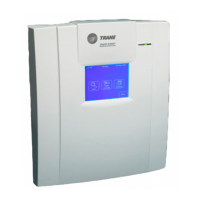Chapter 6 Network Wiring
156 BMTW-SVN01F-EN
Calculating Delays
In a conventional ARCNET LAN, the maximum propagation delay
between any two devices cannot exceed 31 µs (microseconds). When calcu-
lating propagation delays, the delay experienced from a hub or cable must
be known. Use Table 31 to calculate propagation delays that are usually
only a problem on geographically large systems.
Although active hubs do not introduce significant delays, the arbitrary
rule is that you cannot cascade more than 10 active hubs in one network.
Assuming 1,450 ft (442 m) links between hubs and 1,450 ft (442 m) links
between the end hubs and devices, a 15,950 ft long (4,861 m) network
results with RG-62/U coaxial cable. This network has a propagation delay
of 19.14 µs, which is within the 31 µs limit for ARCNET. Contact Trane
for systems that exceed 31 µs.
The following example shows how to calculate a propagation delay. Fiber-
optic propagation delay is calculated in the same manner.
Total feet × delay = propagation delay
In feet:
15,950 ft × 0.12
µs/100 ft = 19.14 µs
In meters:
4,681 m × 0.12
µs/30 m = 19.14 µs
Ethernet Communication
An Ethernet LAN system used with Tracer Summit can support many
combinations of BCUs and PC Workstations. All devices (BCUs and PC
Workstations) in a LAN system must have standard Ethernet hardware
installed.
Note:
There are no propagation delays in an Ethernet LAN.
Table 31. ARCNET LAN Propagation Delays
ARCNET Component Delay
Active hub
0.25
µs/hub
RG-62 coaxial cable
0.12 µs/100 ft (30 m)
62.5 µm (micrometer)
fiber-optic cable
0.15 µs/100 ft (30 m)

